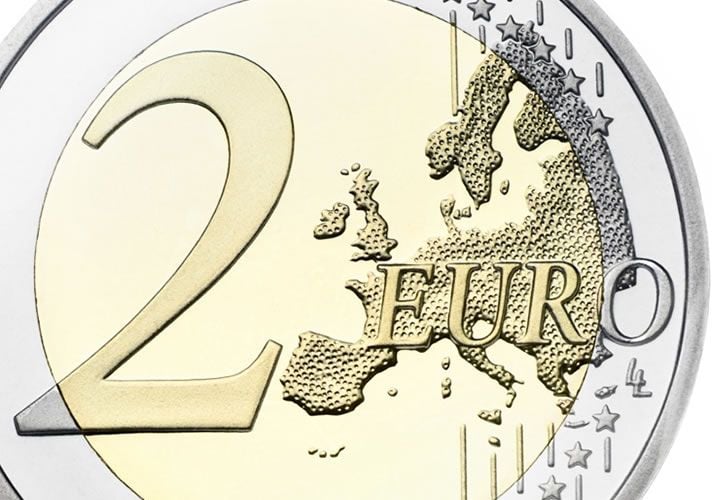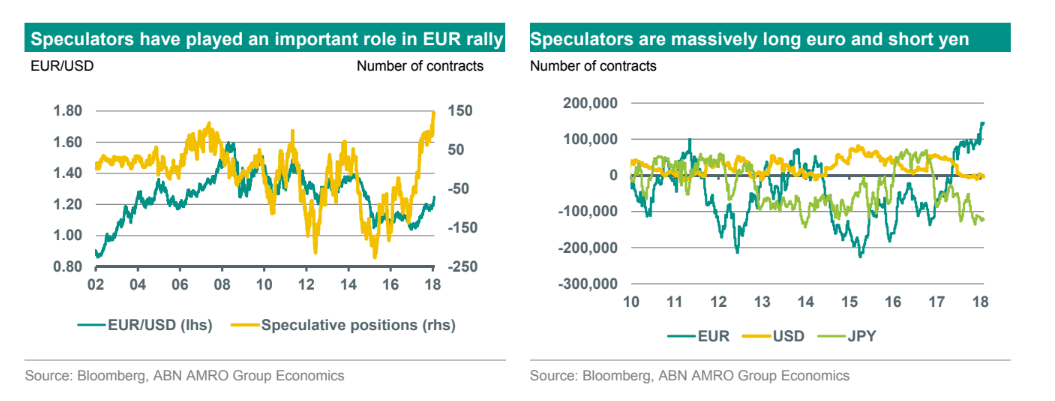Euro-to-Dollar Rate Forecast to Fall to 1.15 Should Global Investor Sentiment Continue Deteriorating

The fate of the EUR/USD uptrend may hinge on the status of global investor sentiment as much as anything else.
There is now a heightened risk of the Euro-to-Dollar pair falling from souring investor sentiment, according to analysts at ABN Amro.
A more sombre sentiment has weighed on equities, commodities and emerging market currencies over the last few days and coincided with the Dollar's recent recovery.
"Since the end of last week, the US Dollar has recovered somewhat. The main question is why as ECB President Draghi has not been able to talk down the Euro. The answer is that the continued rise in bond yields has unnerved investors and investor sentiment on financial markets has deteriorated," says ABN Amro senior FX strategist Georgette Boele.
The main reason why the Dollar came under pressure during its most recent bout of weakness at the end of 2017 was due to capital flows increasingly being diverted to more attractive prospects in emerging markets, which are seen as ripe for growth.
The reason why the Dollar has recovered, therefore, argues Boele, is the inverse of that - a fall in general global risk appetite and a loss of faith in external economies.
So global investor sentiment matters.
"As the US dollar has been under pressure in a risk-on environment subsequently if investor sentiment deteriorates the US dollar safe-haven appeal is attractive again," says Boele.
In relation to EUR/USD, Boele sees this new risk relationship as posing a bearish threat.
The market is heavily bought into the Euro as many speculators have expected it to rally - this trade is now so saturated it is at risk of a sell-off on profit-taking.

The trigger for the crowded Euro long bet, could be a sudden change in sentiment to a more risk-averse global outlook - which would also propel the US Dollar side of the pair higher.
As such ABN Amro forecast a fall to 1.15 for EUR/USD on the horizon.
Get up to 5% more foreign exchange by using a specialist provider to get closer to the real market rate and avoid the gaping spreads charged by your bank when providing currency. Learn more here.
Euro a Safe-Haven Too?
Although it makes perfect sense that the Dollar could rise on a depressing outlook for global growth - given the opposite is true when the outlook is positive, and the Euro long-bet is full - there is evidence to suggest that EUR/USD may not be the best expression of falling investor sentiment.
This is because the Euro is itself something of a safe-haven due to its combination of low-interest rates, which makes is a popular currency to borrow and invest with and its high current account surplus.
The former reason means that when risk appetite falters investors are apt to pull their money out of risky assets and repatriate them to Euro-land where they originally borrowed the money - causing a rise in 'safe-haven demand'.
During the Korean missile crisis on August 29, the Euro actually rose against the Dollar due to it benefiting from more safe-haven flows than the Dollar.
"One interesting recent development in the currency markets has been the evolution of the euro (FXE) as a safe haven. The European Central Bank is raring to reduce its stimulus program, encouraged by improving economic conditions and a relatively stable political climate, so the euro is gaining its place in safe-haven currencies. The euro broke the 1.20 level against the US dollar and managed to close at 1.1970," says Ricky Cove financial writer at Market Realist, in relation to the event.
The Long View
One of the things analysts, including ABN Amro's Boele have noticed, is that although US bond yields have been rising more than their counterparts for quite a while now, the Dollar has not followed suit - not until the last few days, that is.
Normally this would not be the case as a country with higher national (sovereign) bond yields tends to see its currency rise more than a country with lower yields because yields represent the compensation bondholders recieve for inflation errosion, and are thus a statement of market inflation expectations.
Thus higher yields mean higher inflation, and higher inflation results in higher interest rates, which tend to boost a currency because higher interest attracts greater inflows of foreign capital drawn by the promise of 'return'.
According to many analysts, the main reason higher US yields previously failed to stimulate a stronger Dollar was due to the fact that the higher yields were mainly concentrated in shorter-duration bonds of 2 years.
Longer term US bond yields did not rise as much due to perpetually low longer-term inflation expectations, and this weighed on the Dollar.
Recently the 10-year US Treasury bond yield has surged higher, going above the key 2.7% level, however, on the back of a rising longer-term inflation outlook, which suggests interest rates may go higher than was previously thought in the longer-term.
This 'improvement' in the medium-to-longer term prospects of US growth and inflation have stimulated the recovery in the Dollar, according to analysts such as Société Générale's analyst Alvin Tan and ACLS Global's chief strategist Marshall Gittler - to name but a few.
The rise in the Dollar and yields, therefore, may not be just because of a change in global risk sentiment, but also because of a change in outlook for US interest rates as well.
Get up to 5% more foreign exchange by using a specialist provider to get closer to the real market rate and avoid the gaping spreads charged by your bank when providing currency. Learn more here.
